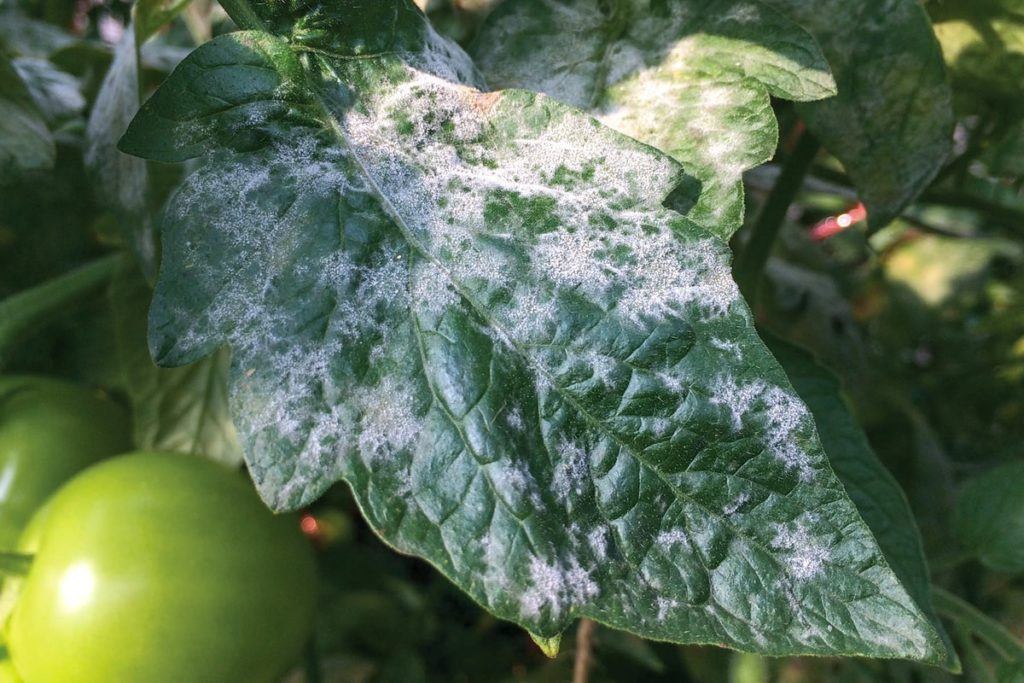
Oídio
WHAT IS AND HOW TO ELIMINATE
Powdery Mildew
Oidium neolycopersici
Pathogen:
Fungus
Type:
Risk to the plant:
HIGH



DESCRIPTION
WHO CAUSES IT?
Oidium neolycopersici is a biotrophic fungus that affects tomato crops in various regions of the world. Its development begins with the germination of conidia on the surface of the plant, which form germ tubes capable of penetrating the cuticle and establishing haustoria in the epidermal cells. These haustoria allow the fungus to extract nutrients without immediately destroying the cells, making it easier to spread throughout the plant. As the infection progresses, the fungus generates mycelium on the affected tissues, forming a characteristic white powdery layer that contains new reproductive structures. Conidia are dispersed primarily by wind and can survive in the environment until they find suitable conditions to germinate on another susceptible plant. In the absence of an active host, the pathogen can persist in plant debris or nearby solanaceous weeds, contributing to its reappearance in the following season.
SYMPTOMS
In tomatoes, powdery mildew caused by Oidium neolycopersici initially appears on the lower leaves, where whitish spots with a dusty appearance appear. As the disease progresses, these spots extend to the upper leaves, stems and even fruits, affecting photosynthesis and weakening the plant. Under favorable conditions, the fungus spreads rapidly, causing defoliation and reduced crop yield.
- Presence of white powdery spots on the upper and lower sides of the leaves.
- Drying and yellowing of the affected leaves.
- Premature defoliation in severe infections.
- Decrease in the development and vigor of the plant.
- Reduction in the quality and size of the fruits.
- Appearance of whitish lesions on stems and petioles in advanced cases.


TEMPERATURE AND HUMIDITY
18°C - 28°C
60% - 90%

HOW IS IT SPREAD?
Wind-borne spores, contact with contaminated tools, infected plant debris, nearby solanaceous weeds, insect vectors, infected transplants

HOW TO REMOVE IT?
Home remedies
There are no home treatments
Chemical treatments
• AZOXISTROBIN 20% + DIFENOCONAZOLE 12.5% [SC] P/V
• AZOXISTROBIN 25% [SC] P/V
• SULFUR 80% [DP] P/P
• SULFUR 80% [SC] P/V
• SULFUR 80% [WG] P/P
• SULFUR 80% [WP] P/P
• SULFUR 82.5% [SC] P/V
• SULFUR 98.5% [DP] P/P
• SULFUR 99% [DP] P/P
• BUPIRIMATE 25% [EC] P/V
• CIFLUFENAMID 10% [SC] P/V
• COS-OGA 1.25% [SL] P/V
• DIFENOCONAZOLE 12.5% + CYFLUFENAMIDE 1.5% [DC] P/V
• DIFENOCONAZOLE 25% [EC] P/V
• EUGENOL 3.3% + GERANIOL 6.6% + THYMOL 6.6% [CS] P/V
• FLUOPYRAM 40% [SC] P/V
• FLUXAPYROXAD 7.5% + DIFENOCONAZOLE 5% [SC] P/V
• POTASSIUM HYDROGEN CARBONATE 0.425% [AL] P/V
• POTASSIUM HYDROGEN CARBONATE 85% [SP] P/P
• KRESOXIM-METHYL 50% [WG] P/P
• LAMINARIN 4.5% [SL] P/S
• Penconazole 10% [EC] P/V
• PENCONAZOLE 20% [EW] P/V
• PIRACLOSTROBIN 6.7% + BOSCALIDE 26.7% (I) [WG] P/P
• TEBUCONAZOLE 25% [WG] P/P
• TETRACONAZOLE 12.5% [ME] P/V
• TETRACONAZOLE 4% [ME] P/V
• TRIFLOXISTROBIN 50% [WG] P/P
Authorized treatments in organic farming
• SULFUR 80% [DP] P/P
• SULFUR 80% [SC] P/V
• SULFUR 80% [WG] P/P
• SULFUR 80% [WP] P/P
• SULFUR 82.5% [SC] P/V
• SULFUR 98.5% [DP] P/P
• SULFUR 99% [DP] P/P
• COS-OGA 1.25% [SL] P/V
• EUGENOL 3.3% + GERANIOL 6.6% + THYMOL 6.6% [CS] P/V
• POTASSIUM HYDROGEN CARBONATE 0.425% [AL] P/V
• POTASSIUM HYDROGEN CARBONATE 85% [SP] P/P
• LAMINARIN 4.5% [SL] P/S
Insect allies
EFFECTIVE PRODUCTS TO ELIMINATE THIS PEST
Sponsored link
Sponsored link
Sponsored link
Sponsored link
Sponsored link
Sponsored link
Effective against all types of fungi
- Use tomato varieties with genetic resistance to Oidium neolycopersici to reduce the susceptibility of the crop.
- Maintain adequate spacing between plants to improve air circulation and reduce humidity in the foliage.
- Avoid sprinkler irrigation, as it favors the dispersion of conidia and the spread of the pathogen.
- Remove and destroy remains of infected plants to eliminate sources of inoculum and reduce infection pressure.
- Implement crop rotation with non-susceptible species to reduce the presence of the fungus in the environment.
- Apply preventive fungicides at key times, such as the beginning of vegetative growth and flowering, to reduce the incidence of the disease.
- Use biofungicides based on Trichoderma spp. or other antagonistic microorganisms for the biological control of the fungus.
- Avoid excess nitrogen fertilization, as it can promote the growth of tender tissues more susceptible to infection.
- Monitor the crop frequently to detect the first symptoms and apply control measures in a timely manner.
- Disinfect cultivation tools and structures to prevent the spread of the pathogen.
- Apply plant extracts with antifungal properties, such as garlic, cinnamon or baking soda, as a complement to integrated management strategies.
























